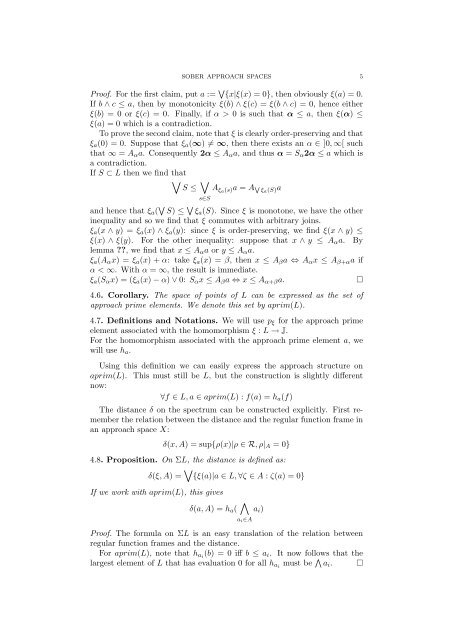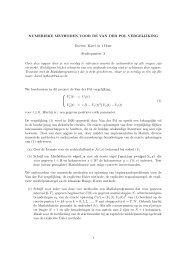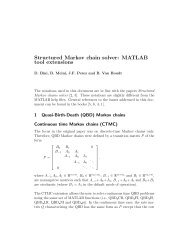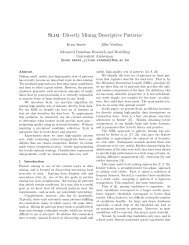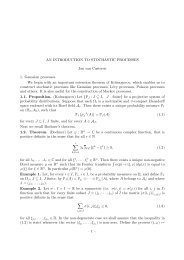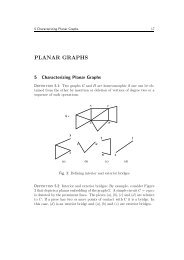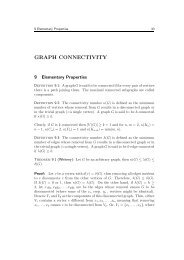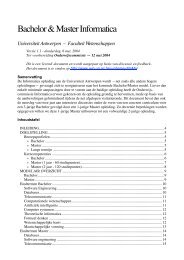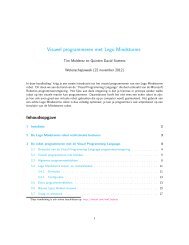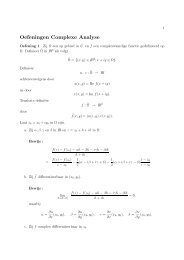SOBER APPROACH SPACES 1. Introduction In this article we will ...
SOBER APPROACH SPACES 1. Introduction In this article we will ...
SOBER APPROACH SPACES 1. Introduction In this article we will ...
Create successful ePaper yourself
Turn your PDF publications into a flip-book with our unique Google optimized e-Paper software.
<strong>SOBER</strong> <strong>APPROACH</strong> <strong>SPACES</strong> 5Proof. For the first claim, put a := ∨ {x|ξ(x) = 0}, then obviously ξ(a) = 0.If b ∧ c ≤ a, then by monotonicity ξ(b) ∧ ξ(c) = ξ(b ∧ c) = 0, hence eitherξ(b) = 0 or ξ(c) = 0. Finally, if α > 0 is such that α ≤ a, then ξ(α) ≤ξ(a) = 0 which is a contradiction.To prove the second claim, note that ξ is clearly order-preserving and thatξ a (0) = 0. Suppose that ξ a (∞) ≠ ∞, then there exists an α ∈ ]0, ∞[ suchthat ∞ = A α a. Consequently 2α ≤ A α a, and thus α = S α 2α ≤ a which isa contradiction.If S ⊂ L then <strong>we</strong> find that∨ ∨S ≤ A ξa(s)a = A W ξ a(S)as∈Sand hence that ξ a ( ∨ S) ≤ ∨ ξ a (S). Since ξ is monotone, <strong>we</strong> have the otherinequality and so <strong>we</strong> find that ξ commutes with arbitrary joins.ξ a (x ∧ y) = ξ a (x) ∧ ξ a (y): since ξ is order-preserving, <strong>we</strong> find ξ(x ∧ y) ≤ξ(x) ∧ ξ(y). For the other inequality: suppose that x ∧ y ≤ A α a. Bylemma ??, <strong>we</strong> find that x ≤ A α a or y ≤ A α a.ξ a (A α x) = ξ a (x) + α: take ξ a (x) = β, then x ≤ A β a ⇔ A α x ≤ A β+α a ifα < ∞. With α = ∞, the result is immediate.ξ a (S α x) = (ξ a (x) − α) ∨ 0: S α x ≤ A β a ⇔ x ≤ A α+β a.□4.6. Corollary. The space of points of L can be expressed as the set ofapproach prime elements. We denote <strong>this</strong> set by aprim(L).4.7. Definitions and Notations. We <strong>will</strong> use p ξ for the approach primeelement associated with the homomorphism ξ : L → J.For the homomorphism associated with the approach prime element a, <strong>we</strong><strong>will</strong> use h a .Using <strong>this</strong> definition <strong>we</strong> can easily express the approach structure onaprim(L). This must still be L, but the construction is slightly differentnow:∀f ∈ L, a ∈ aprim(L) : f(a) = h a (f)The distance δ on the spectrum can be constructed explicitly. First rememberthe relation bet<strong>we</strong>en the distance and the regular function frame inan approach space X:δ(x, A) = sup{ρ(x)|ρ ∈ R, ρ| A = 0}4.8. Proposition. On ΣL, the distance is defined as:δ(ξ, A) = ∨ {ξ(a)|a ∈ L, ∀ζ ∈ A : ζ(a) = 0}If <strong>we</strong> work with aprim(L), <strong>this</strong> givesδ(a, A) = h a ( ∧a i )a i ∈AProof. The formula on ΣL is an easy translation of the relation bet<strong>we</strong>enregular function frames and the distance.For aprim(L), note that h ai (b) = 0 iff b ≤ a i . It now follows that thelargest element of L that has evaluation 0 for all h ai must be ∧ a i . □


